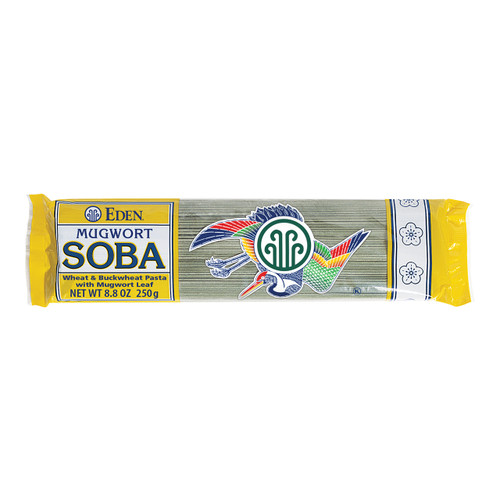Rich nourishing soba noodles artisan crafted of hard winter and hard spring wheat, whole buckwheat flour, wild yam flour, and a bit of sea salt. Wild yam (jinenjo) Dioscorea japonica is an energizing root vegetable from rugged mountains valued for promoting strength and well-being. Tanaka family made as they've been doing it since 1906, now with four generations actively involved. Ideal for making noodle sushi and in dashi - a shoyu soy sauce kombu broth, or drizzled with ponzu. A good source of protein and complex carbs. ![]()
MORE DETAILS
Eden Wild Yam Soba noodles are hard winter and hard spring wheat, whole buckwheat flour, wild yam flour, and a bit of sea salt. Tanaka family made as they've been doing it since 1906, now with four generations actively involved. Jinenjo Soba is a delicious and easy way to enjoy the flavor and exceptional health benefit of buckwheat and wild yam.
Eden Wild Yam Soba is wheat flour sifted to remove most of the bran and germ, which is reserved. A good percentage of the reserved bran and germ is added back into the dough as it's kneaded. Dried wild mountain yam (jinenjo) is ground to a fine powder and added to the sifted wheat and whole buckwheat flour. Dough is kneaded with pure water and sea salt. Salt binds the dough, enhances flavor, and preserves the dried pasta. Dough is rolled out and folded onto itself eight times, then cut to length. Long strands of noodles are lifted onto racks, rolled into drying rooms, and allowed to dry slowly for up to two days depending upon thickness and ambient temperature, humidity. Dutifully tended, they are hand-cut and packed when perfectly finished. Patience and a no-shortcut approach create superior texture, flavor, and ultimately well nourished well-being
Historical Information
Soba is the Japanese word for buckwheat Fagopyrum esculentum, a nearly forgotten healthy food with rich flavor and many benefits. Buckwheat Fagopyrum esculentum is a hardy, wild broad leaf plant and not a grass. It belongs to the Polygonaceae or buckwheat family and is not a member of the cereal grain or Gramineae family. The fruit seed of buckwheat has long been valued in both East and West. It is believed to have originated in the area of Lake Baikal in Siberia, in the Himalayas, and Manchuria. Buckwheat was cultivated and eaten in China before being adopted throughout Asia and Europe. It has been a staple in Russia and central Europe for centuries where it's known as 'kasha.' Buckwheat's protein is superior to that of most cereal grains providing all amino acids including the essential ones. Buckwheat is the best source of rutin, an important vitamin C complex flavonoid.
The art of making noodles is believed to have originated among farmers in China. Noodles were adopted by Buddhist temples and were brought to Japan by monks. The first reference to buckwheat in Japan appears in records from the Heian period (794 to 1185 A.D.). Buckwheat noodles or 'soba kiri' are mentioned in documents from the early 1600s.
Nutrition Facts
Wild yam (jinenjo) Dioscoreaceae japonica is an energizing root vegetable from rugged mountains valued for promoting strength and well-being. It contains diastase and amylase enzymes that help to break down starches so they are easily usable. Eden Wild Yam Soba is a good source of protein, low fat, saturated fat and cholesterol free.
Commercial pasta is highly refined, chemically treated flour, processed in minutes through teflon dies and ultra high heat or microwave drying resulting in inferior flavor, diminished nutrition, and dubious value. Eden Wild Yam Soba is a wise choice. Light, delicious and nourishing because it's made with patience, care, the best ingredients, and handling that enhances value.
Eden Wild Yam Soba is delicious, warming and strengthening food enjoyed hot or chilled in dashi broth with shoyu, kombu sea vegetable, shiitake mushroom, and mirin, or drizzled with ponzu. Use like any pasta in soups, stir-fries, and salads. Wrap it in toasted nori to make noodle sushi. Do not add salt to the cooking water. Unlike Eden Organic Soba and Udon, these Japanese made noodles contain sea salt.
Traditional Cooking Instructions for Japanese Noodles
Soba and Udon can be boiled just like other pasta or you can use a traditional Japanese cooking method which takes a little longer but is well worth it. This method is called the shocking method, cold water is added to boiling water several times during the cooking process creating a firmer, al dente noodle. For this method place 2 quarts of cold water in a large pot, cover, and bring to a boil. Remove the cover, add the noodles, and stir to prevent sticking. As soon as the water comes to a boil again, add enough cold water to stop the water from boiling (about a 1/2 cup). Bring to a boil again, and add cold water again. Repeat one or two additional times until the noodles are done. Periodically check the noodles by removing a strand and biting or cutting it in half. If the center of the noodle strand is white and the outside is darker, the noodles are not done. When the center of the noodle is the same color as the outside, and the noodles are firm yet tender to the bite they are done. Rinse cooked Udon and Soba noodles under cold water. This lowers sodium and prevent clumping.

















